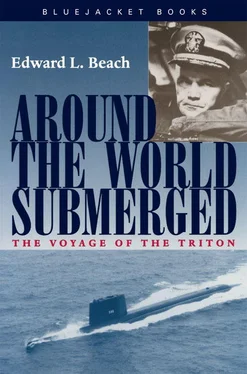Life in the peacetime Navy was, of course, very different from the war years. I spent periods in the Navy Department in Washington and periods at sea. There was a moment of deep grief when our first child, little Inga, aged three years and a week, died suddenly in Key West, Florida. There was a period of professional triumph when my ship, the Amberjack, pioneering new tactics to exploit her revolutionary streamlined shape, was for a time the most battle-worthy submarine in the force.
Happily, we had more children; two boys and another little girl. I spent some time on the staff of General Omar N. Bradley while he was Chairman of the Joint Chiefs of Staff, and then went to sea in command of the newly constructed submarine, Trigger (SS564). Despite the heritage of her name, this ship, named after my old destroyed Trigger, was a great sorrow. Her engines, poorly designed and put into service after insufficient testing, were not dependable.
My indignation ran high. Diesel engines had long since been perfected. At one time submariners had assisted in their development, but that job had been done, the principles proven. Now, our job, as I saw it, was to operate the ships, develop tactics for them, and test their combat capabilities—not help to build diesel engines any more. One of the three types of diesel engines with which we had fitted our boats before the war had proved to be an inglorious failure, thus endangered the lives of the crews. The most worth-while contribution Trigger II could make, I felt, was to prevent this from happening again by being forthright about the deficiencies. But condemnation of the new engines was not well-received in the Navy Department, where a more popular view was that submarine skippers should spend their time stoically trying to make their boats run instead of documenting their faults. Vainly, I argued that glossing over its manifest undependability for war service was precisely what had been done with the pre-war HOR engine (sometimes, with a deep tone of disgust, the initials were pronounced as a word), with the result that it was not taken off the line soon enough. Ultimately all of them were replaced, but not before men had fought the enemy in defective ships and come back in passionate anger. It was one lesson we had learned well: no operational commander would send a ship like the new Trigger on any important mission in war, I said.
The controversy was still going on when we had occasion to put Trigger in dry dock one day in January, 1953. During dry-dock operations, there is a short time when your ship is completely out of communication with the outside world. It is impossible for anyone to go ashore, and telephones are not yet hooked up. Temporarily, you are entirely incommunicado. It was while Trigger was in this condition that a large overhead crane swung toward us from the dock, and someone noticed a telephone hanging from the crane’s hook. Seconds later, the crane, capable of lifting twenty tons, laid the five-pound telephone gently on our afterdeck. It was ringing steadily.
“It’s for you, Captain.” The sailor answering the phone still wore the surprised look with which he had picked it up. The caller was an officer in the Bureau of Naval Personnel. He wanted me to come to Washington as soon as possible, but would not say why. I spent the next several hours worrying. The only reason anyone would want me in Washington, so far as I could guess, was to be unpleasant about my attitude toward the Navy’s new submarine diesel engines.
I caught the night train, was in Washington early the next morning, and was directed to report to the headquarters of the President-elect of the United States at a downtown hotel. There, after several minutes of aimless conversation with busy people, a singularly pleasant, soft-spoken, and slender gentleman, whom I later discovered to be Major General Wilton B. Persons, USA (ret.), suddenly asked, “Would you like to be the President’s Naval Aide?”
The question caught me by surprise, as no doubt it was intended to do. What I knew about naval aiding a President was not impressive. I remember wondering whether it would be anything like working for General Bradley, and, in virtually the same thought, whether he might have had anything to do with suggesting me. And I remember also thinking quickly that coming ashore meant I would no longer be “attached to and serving on board a submarine.” This would automatically result in a pay cut amounting to $180.00 a month.
But that is about all I recall of the interview, for the next thing I found myself saying was that I would like the job, if Mr. Eisenhower wanted me. A friendly Army colonel by the name of Pete Carroll introduced me to a few more people and then showed me out. “When do I start?” I asked him.
“You’ve started,” he replied.
The four years I served as Naval Aide to the President are, of course, among the most precious recollections my wife and I have. To be associated in any capacity with the President of the United States and to have had the opportunity to earn his regard is a piece of good fortune which cannot fall to many.
I soon found that a tremendous amount of official paper flows every day between the White House and the Pentagon. About ninety-five percent of this paper is routine—and the Navy’s portion of this reaches the President through the Naval Aide. Naturally, there were other duties, too.
One of the more pleasant tasks which fell to me was that of making the arrangements for Mrs. Eisenhower’s christening of the Nautilus. The affair burgeoned from a rather simple expedition to an elaborate operation, involving special trains, special protocol arrangements, and all sorts of intricate details in New London.
During a moment of leisure after the 1956 campaign, I communicated to the President my feeling that as a career naval officer I should not remain longer than four years in the position I then held. His ready understanding has been one of my warm memories of him.
The Navy Department concurred in my desire for sea duty, and since I had recently attained the rank of Captain, I was assigned to command one of the fast fleet oilers serving our forces in the Mediterranean. Salamonie, or “Old Sal” as we dubbed her, had been built for the Standard Oil Company as a so-called “super-tanker” just before the war. Taken over by the Navy before completion, she had been a part of the fleet ever since, and when I saw her, she bore the scars of many years of strenuous operations.
Almost all my time on board was spent at sea in the Mediterranean, fueling ships and fighting rust, and as we prepared to leave that strategic area, I was amazed at the tabulated number of ships we had refueled and the quantity of fuel oil, gasoline, and jet fuel we had pumped through our tanks. We had serviced an average of four ships per day, and on some days we counted as many as twenty-four ships alongside during a twenty-four-hour period.
During the Salamonie ’s return trip to the United States, in December of 1957, she had a brief moment of distinction when three destroyers, caught in a lengthy period of bad weather at sea, began to run perilously low on fuel. We were the only ship in the vicinity, and after three days of struggle at the tail end of a North Atlantic hurricane, we managed to get fuel to the three ships and save the situation. It was a strenuous operation from the heaving, pitching deck of the Salamonie, and it must have been even more so from the destroyers’ point of view.
During the first day, a heavy sea swept a man overboard from one of them; snatched him, in fact, from the boat deck, a full deck higher than the ship’s main deck. To launch a lifeboat was impossible; we were all pitching too violently, and even “Old Sal” was rolling her decks under. By good fortune, I happened to be looking at the Gearing through my binoculars at the very moment her signal searchlight began to spell out the words, “MAN OVERBOARD,” and read the electrifying message direct. In this situation Salamonie, being the biggest ship present, had the advantage; and we were able to maneuver into position to pick the man up by sending a strong swimmer with a line fastened to his waist into the fifty-foot seas after him. The volunteer who thus risked his life to save another was Lawrence W. Beckhaus, then a Gunner’s Mate Second Class.
Читать дальше












